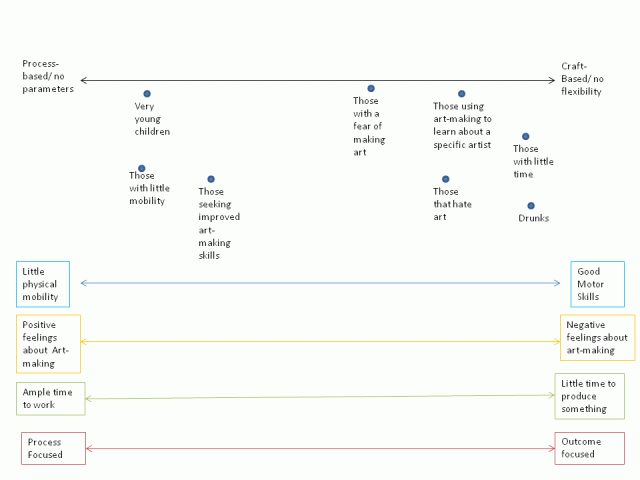I need to get a number of confessions out. I love crafting. I self-classify as a crafter. I even have a blog about crafting with kids, Art Play Space. And, I don’t think functional art, often classified as craft, is neither fine nor art.
All that said, there is a class of things that museum professionals and art teachers teach in the studio that I would say are craft. Use this set of prescribed materials to get this product that looks very similar to the sample the teacher made. Your gauge of success will be how similar it is to the sample—and how good it looks. Your chance to innovate will be within some specific, carefully gauged parameters.
This type of activity is in opposition to something that is more focused on creativity. In an idealized world, this would be something where you have many types of materials available for students. The choice of materials would be up to the students. The resulting project would also come from their creativity.
Consider these illustrations. On the open-ended side, imagine a printmaking class, where 2-3 different processes are described and demonstrated and then students are invited to create. On the prescribed end of the spectrum, imagine a dragon puppet where the eyes, horns, mouth, teeth, nostrils, ears where everything was pre-cut for students to assemble.
The projects that are taught in the museum classroom are on the continuum of prescribed projects and completely open ones. I have come to see the value of both types of projects.
Reasons for Using Crafts in Museums Studio Classrooms:
- Following the directions: This is a world where in some instances following the directions is essential to success. Going on vacation is a set of situations in which you had to follow directions. Miss a step and you won’t be getting on the plane.
- Fine motor skills: Using scissors and an exacto to precisely replicate a given form is hard. Craft is a way that the student will be able to see their deficiencies. If your project is ovoid rather than expected square, you will be able to see where you have cut incorrectly.
- Satisfaction: Finishing a project that looks as it can feel good. Making art can feel good. But, if you are scared of creativity, crafting can be a gateway drug.
- Frameworks for Innovations: A blank sheet of paper can be scary to some people. But, give them a little structure, and they will be safe enough to be creative.
- Pretty: Any art historian knows that art doesn’t have to be pretty. That said, for millennia humans have surrounded themselves with items whose function is beauty. Creating works that are prized for being aesthetically pleasing fulfills a primal need.
On the more creative end of the spectrum:
- Rules are meant to be broken: Innovation is hard to teach but easier to foster. Teaching students how to be creative without rules can have effects throughout their lives.
- Techniques: Focusing of the techniques, say bookmaking, you are allowing students to immerse themselves in process.
- Ugly: Art can be an expression. Creating something that is totally about process give you an insight onto many museum collections. Creating an impasto painting that speaks to you is one way to gain new insight into Joan Mitchell.
The issue is how your proposed project lands on this spectrum, and this is related to your students. For very young students, process based works, devoid of specific results, can be ideal. Painting is wonderful to preschoolers, who by nature are predisposed to immersing themselves in process.
The real litmus test isn’t age but instead interest about ability. If your proposed group of students is scared of art, or unfamiliar with making stuff, then the project should have a visually pleasurable result. But, if this same group doesn’t have good fine motor skills, then you might still prick something with multiple visually appealing outcomes. For elementary, you might do splatter painting. You might think of it this way:

